Menus
- Tourers with shifting aids in comparison
- Tourer with shifting aids part 1
- The AS version of Yamaha’s FJR 1300 comes with an electronically adjustable chassis as standard
- Tourer with shifting aids part 2
- Heavy boxes: the three cars weigh over 800 kilos in total
- It takes a while for the Honda VFR 1200 F DCT to move
- From 4000 rpm the Honda VFR emits a wonderful V4 staccato
- The FJR would do just fine with a 6-speed transmission
- The Yamaha FJR 1300 AS also tries to start in 5th gear
- The BMW can do better
- The BMW’s Vmax is 285 kilometers per hour
- MOTORCYCLE points evaluation / conclusion
- Tourer technology: shift assistants
- Technical specifications
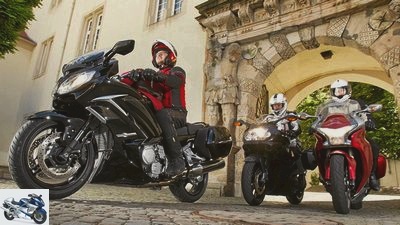
Arturo Rivas
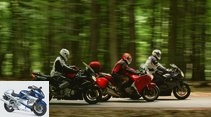
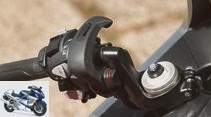
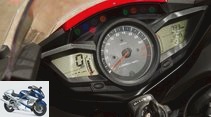
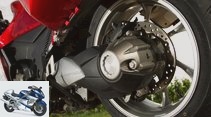
30th photos

Rivas
1/30
Comparison test: Tourer with shifting aids – BMW K 1300 S, Honda VFR 1200 F DCT and Yamaha FJR 1300 AS.
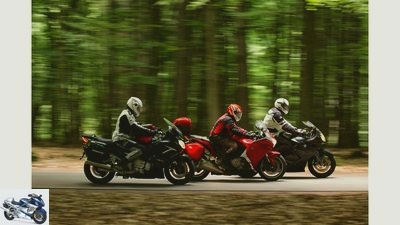
Rivas
2/30
Comparison test: Tourers with shifting aids – BMW K 1300 S, Honda VFR 1200 F DCT and Yamaha FJR 1300 AS.
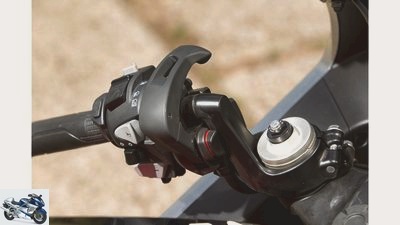
Rivas
3/30
Up / downshifts plus parking brake on the left.

Rivas
4/30
V-shaped: digital speedometer and on-board computer with essential information to the right and left of the rev counter.
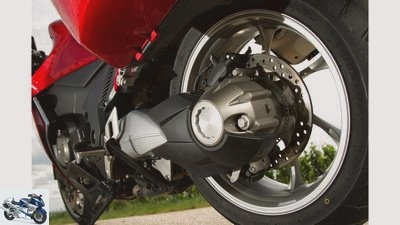
Rivas
5/30
Massive: Cardan single-sided swing arm without torque support, but with a constant velocity joint inside.
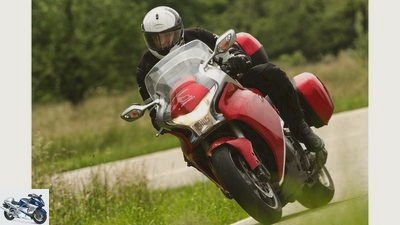
Rivas
6/30
Honda VFR 1200 F DCT: the golden mean? As a sports tourer, the spacey designed VFR should mediate between the extremes. And since 2012 with the second generation of Honda’s exclusive dual clutch transmission – for an extra 1000 euros on board. Then, as with the Yamaha FJR 1300 AS, a clutch lever is missing. Luggage set and main stand are standard equipment, but the top case and top pane cost extra.
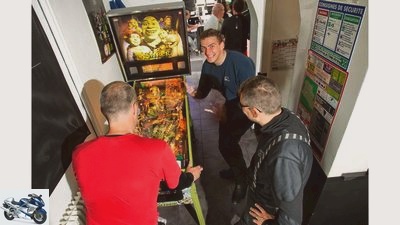
Rivas
7/30
As before: pinball fun.
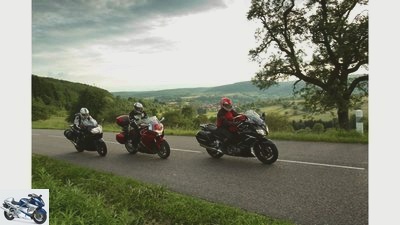
Rivas
8/30
Quiet: deserted north Vosges.
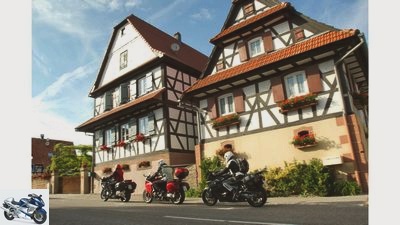
Rivas
9/30
Picturesque: half-timbered houses in Alsace.
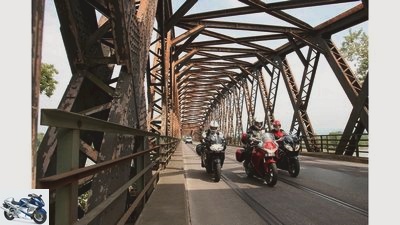
Rivas
10/30
Across the Rhine: to France.
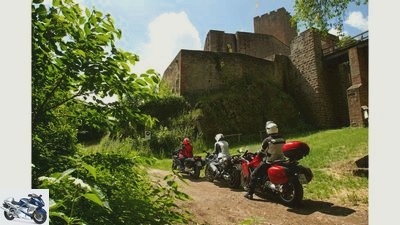
Rivas
11/30
Mightily defiant: Landeck Castle.

Rivas
12/30
BMW K 1300 S: The faster, the better: The machine from Berlin embodies the athlete of the trio. Better the Nordschleife than a long-distance journey. In addition, the “K, as the lightest machine, offers the lowest degree of automation: its shift assistant, in conjunction with the conventional clutch, allows lightning-fast upshifts without having to engage and disengage. Works best under load.
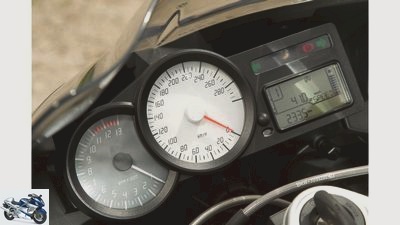
Rivas
13/30
Status 2004: outdated on-board computer with small displays, speedometer with twisted scale.
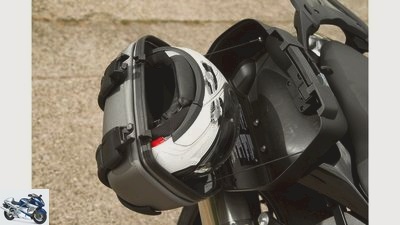
Rivas
14/30
Smart: Small “pull-out boxes” swallow full-face helmets. Waterproof only with inside pockets.
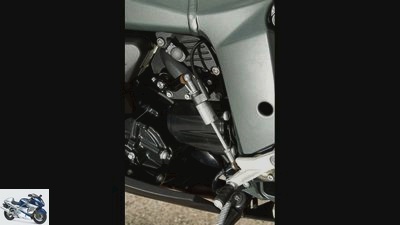
Rivas
15/30
Shift and control: With the BMW, the shift assistant allows upshifting without using the clutch for a surcharge of 365 euros.
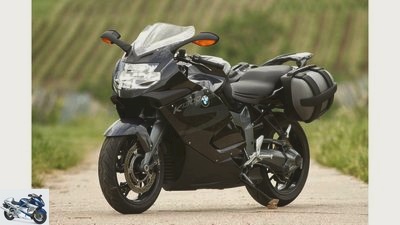
Rivas
16/30
BMW K 1300 S..
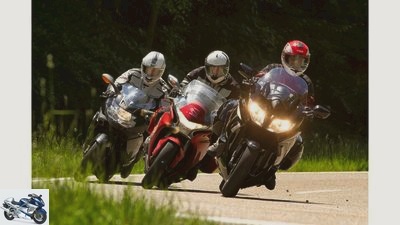
Rivas
17/30
Far, fast, good: switch off jerk-free.
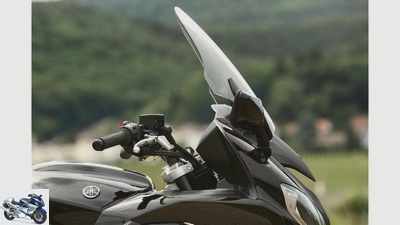
Rivas
18/30
Protective: the electrically adjustable window opens at the push of a button.
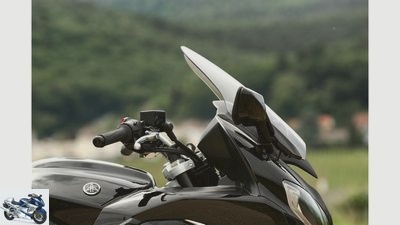
Rivas
19/30
Protective: the electrically adjustable window rises at the push of a button.
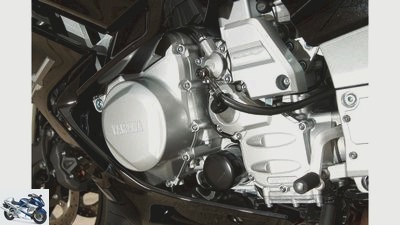
Rivas
20/30
With the Yamaha FJR 1300 AS you cannot couple yourself, this is done by a servo motor.
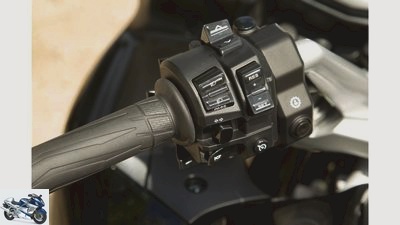
Rivas
21/30
Overloaded: left handlebar fitting with nine switches.
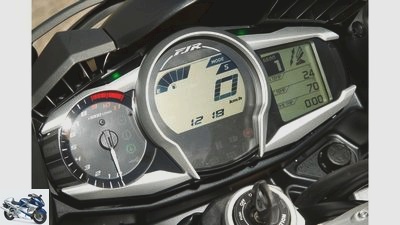
Rivas
22/30
Infotainment: newly designed, clear instruments. Maximum information content!
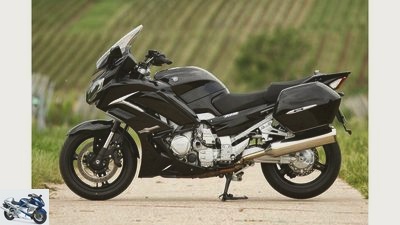
Rivas
23/30
Yamaha FJR 1300 AS.
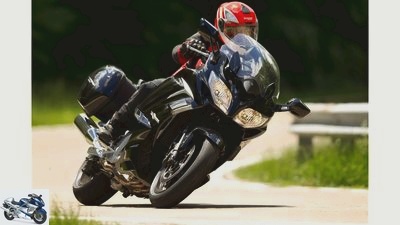
Rivas
24/30
Yamaha FJR 1300 AS: The AS version of the traditional tourer has an automated manual transmission with a fully automatic clutch. Plus an upside-down fork and electronically adjustable chassis.
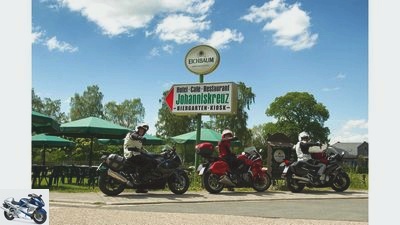
Rivas
25/30
No pleasure: Treff Johanniskreuz.
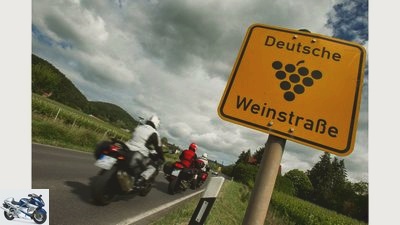
Rivas
26/30
Enjoyment: tour first, then drink.
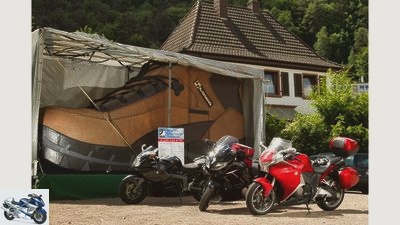
Rivas
27/30
Big Foot: the world’s largest shoe.
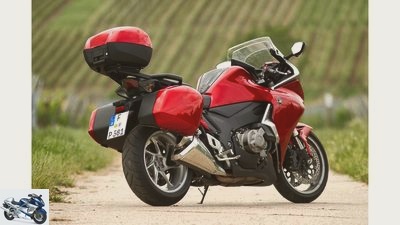
Rivas
28/30
Honda VFR 1200 F DCT.
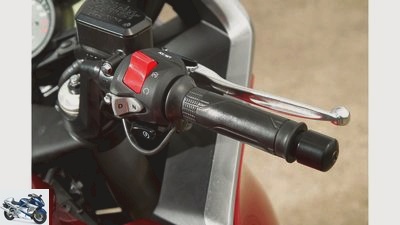
Rivas
29/30
Own: switch for engaging neutral and first gear, switching manual / automatic mode on the right side of the handlebar.
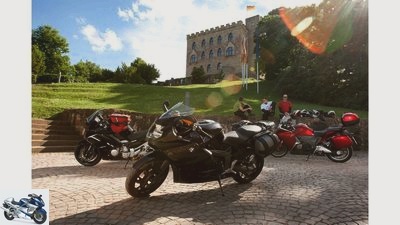
Rivas
30/30
The BMW wins the group test ahead of Yamaha and Honda.
Comparison test BMW K 1300 S, Honda VFR 1200 F DCT and Yamaha FJR 1300 AS
Tourers with shifting aids in comparison
Out and about with special tourers in the beguilingly beautiful Palatinate Forest. Three machines that have a single clutch lever in total. And offer a very different degree of shift assistance. For more enjoyment and autonomous driving when traveling.
Tourer with shifting aids part 1
E.Finally out of the office and into a special motorcycle area: the Palatinate Forest. In the saddle of three great touring motorcycles. Together they combine twelve cylinders with almost four liters of displacement and almost 500 hp. That should be enough for an entertaining two-day tour! Especially since all three are spoiled with shift assistance systems. They help you with coupling and / or shifting. Not of course.
Buy complete article
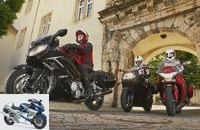
Comparison test BMW K 1300 S, Honda VFR 1200 F DCT and Yamaha FJR 1300 AS
Tourers with shifting aids in comparison
VFR 1200 F DCT and Yamaha FJR 1300 AS. ABS and traction control? Are on board for all conceptual differences (BMW: ASC optional).
The BMW K 1300 S gives the athlete a dash of travel and pillion suitability. The nominally 175 hp Bayern bike has an automatic gearshift integrated into the shift linkage. In contrast, the Yamaha FJR 1300, which was heavily redesigned in 2013, embodies the dynamic, fully equipped tourer par excellence. Here in the AS version (Automatic Shift) with fully automated clutch and automated manual transmission without a separate clutch lever.
The AS version of Yamaha’s FJR 1300 comes with an electronically adjustable chassis as standard
Like the completed BMW, the Yamaha FJR 1300 AS also has an electronically adjustable chassis. Only as standard. Identified by the electrical lines on top of the upside-down fork – the standard FJR has a conventional telescopic fork. The facelift, which also adorns the standard FJR, is eye-catching: the redesigned cladding with larger headlights, light-emitting diode strips and integrated LED indicators. Everything is crowned by the pane that is now moving up and down electrically faster. In 2013, the traditional tourer has a revised cockpit with more functions and standard cruise control such as traction control.
Electronically operated throttle valves enable two different driving modes (mappings). A newly designed airbox with a modified air filter and modified intake funnels are used to improve ventilation. The slightly modified exhaust system with two instead of four catalytic converters rounds off the upgraded 2013 FJR.
Honda’s V4 flagship VFR 1200 F mediates between the two inline four-cylinders. A real sports tourer between the extremes: for the lawn and travel. The VFR, introduced in 2010, received numerous modifications back in 2012. For example case set and main stand as standard. Or powder-coated rims and more functions of the on-board computer (consumption display). There was also new software and a slightly larger tank, now like the BMW K 1300 S with a capacity of 19 liters. Objective: greater range, save fuel, more torque in the lower rev range. Until then, this was not a strength of the 1237 cubic V4 engine.
Rivas
BMW K 1300 S: The faster, the better: The machine from Berlin embodies the athlete of the trio. Better the Nordschleife than a long-distance journey. In addition, the “K, as the lightest machine, offers the lowest degree of automation: its shift assistant, in conjunction with the conventional clutch, allows lightning-fast upshifts without having to engage and disengage. Works best under load.
The VFR was Honda‘s trendsetter for exclusive technology: the first motorcycle with dual clutch transmission DCT (Dual Clutch Transmission). Costs 1000 euros extra, requires ten kilograms more weight. As with the Yamaha FJR 1300 S, the DCT-VFR 1200 lacks a clutch and, in addition, the shift lever on the lower ground floor. It is motorcycles that help the driver to think for him. Does that clear your mind? Or it irritates when the fingers reach into space on the left?
First move into quarters in Bad Bergzabern. In the “Zur Reblaus” inn there are hearty Palatinate home-style cooking that can satisfy even the most hungry for little money. And because the wine comes from our own winery, a good bottle of Pinot Gris costs just three euros to take away.
Tourer with shifting aids part 2
Rivas
Honda VFR 1200 F DCT: the golden mean? As a sports tourer, the spacey designed VFR should mediate between the extremes. And since 2012 with the second generation of Honda’s exclusive dual clutch transmission – for an extra 1000 euros on board. Then, as with the Yamaha FJR 1300 AS, a clutch lever is missing. Luggage set and main stand are standard equipment, but the top case and top pane cost extra.
Next morning, second day. The BMW K 1300 S always wakes up with a wonderful bark. And it can be moved as usual. Your optional shift assistant only helps when shifting up under load. You need a little gas and speed if the transitions are to be smooth. This technology is not intended for city traffic and rush hour. Sure, she also comes from racing.
Wrooup, wrooup, wrooup – the lightning-fast gear changes sound like a rat. On fast straights (approach via the A8), Stefan was able to accelerate the BMW with relish without having to use the clutch. The manual coupling force of the “K” is not small. Heard like that. You have to keep a bearish 140 Newton meters under control.
At home, when determining the rapid BMW driving performance, the colleagues criticized the “jerky” clutch, that is, the clutch that engages somewhat digitally and unevenly. Grab, don’t grab, grab … But who accelerates on tour from a standing start? Nobody, at least not on our journey through Alsace with its picturesque half-timbered houses.
Heavy boxes: the three cars weigh over 800 kilos in total
Flipper break was in Soultz-sous-Forêts in the bar “Le Seven”, where the waitress received us in Alsatian singsong: “The keys, please, I also have a Permis!” She meant her motorcycle license. We could just stop them from the big hooters. Because including suitcases, the cars weigh from 261 kilograms (BMW) to 295 (Honda) up to 306 kilograms (Yamaha). Not for beginners.
For us, this summer evening followed deserted hills in the northern Vosges. The BMW K 1300 S not only played the trump card of its powerful engine to the full on old hill climbs. Again and again you look for a seventh gear because you hardly believe so much thrust in sixth. It’s amazing how the K 1300 S fires out of the corners. It is even stronger in sixth gear than the two much heavier Japanese in fifth.
It takes a while for the Honda VFR 1200 F DCT to move
If desired, the Honda VFR 1200 F DCT can also relieve the driver of shifting gears. But first Alex has to release the parking brake. It sits on the left on the handlebar and acts on the rear brake disc. Without an engine, idling is always possible. Nevertheless, the red humpback whale pushes with difficulty. After all, our 1.90-meter man has accidentally stopped honking his horn: the horn sits above the indicator switch. When starting from cold, the V4 rotates for a long time at increased speed.
Especially when the oil is cold, it takes a few seconds before the clutch hydraulics have built up enough pressure to couple the gears of gear one. When Alex turns off the Honda engine at traffic lights with long red phases, even green cars initially move faster than the Honda VFR 1200 F DCT. Next, up on the wine route, pure pleasure. On tour, it is convenient not to have to switch gears, to let the machine do the work. There are two modes to choose from, the leisurely “D” –like continuous mode and the sportier S mode that operates at higher gearshift speeds.
Own: The D-mode is calibrated for early, often too early upshifts. Swim along in city traffic and whoosh, the Honda VFR 1200 F DCT has zipped up to sixth gear. With only 2000 tours. But when the engine speed is low and the e-gas is barely open, annoying play in the drive train is noticeable; it rattles and claws out of the cardan shaft and engine room. And this despite the fact that Honda revised the control electronics for the DCT in 2012. In favor of better fitting switching points.
So switch to S mode using the switch on the right handlebar switch. Character change at the push of a button. Doctor Jekyll follows Mister Hyde. Because now the V4 remains subjectively in the lower gears for a very long time. “D” switches up early, “S” very late. This means that the 1200 series celebrates well over 100 things in fourth gear when accelerating on country roads. My colleague Computer means too well with his “kick-down” function. Well, at the end on the left you can force the engine to shift up or down using “Tiptronic”. At least as long as the shift command appears plausible to the Honda VFR 1200 F DCT.
The freedom of revving of the 76-degree V4 is enthusiastic. Largest pistons, smallest stroke, “smallest” displacement. An interpretation that you can feel. The purely manual mode, which can be selected using the third DCT switch, is even more fun. He shuts down the “automatic”. Except when stopping, the transmission shifts down all gears on its own. Which, however, requires rougher transitions than if you did it yourself at higher speeds. A little load always helps to fully enjoy the advantages of DCT. Cock the cock when switching!
From 4000 rpm the Honda VFR emits a wonderful V4 staccato
Rivas
Yamaha FJR 1300 AS: The AS version of the traditional tourer has an automated manual transmission with a fully automatic clutch. Plus an upside-down fork and electronically adjustable chassis.
At 3000 rpm the V4 of the Honda VFR 1200 F DCT runs much smoother than at 2000. Shift down again with the left thumb or the index finger up. Goes in a split second and is really quickly internalized. Depending on the gear engaged, the exhaust flap in the funnel-shaped chunky rear silencer opens between 4000 and 5000 rpm. Wow! Now the engine suddenly changes pitch and character. Before, inconspicuously churning like a Citroën 2 CV, now the acoustic V4 staccato comes across.
However, the engine’s vibrations and consumption are now also increasing. Its cleverly chosen crank pin offset (28 degrees) should make a balance shaft unnecessary. Well, the rough running BMW K 1300 S vibrates even more, despite two balancer shafts. Especially when taking off the accelerator and starting at 6000 tours – which you rarely have to enter on country roads. Then the Bayern big block with the steeply inclined cylinders makes your fingers numb.
The FJR would do just fine with a 6-speed transmission
The FJR four-cylinder runs the smoothest, almost like a turbine on 3000 tours, silky smooth. However, it tingles and tickles more intensely at medium speeds from 4000 rpm – annoying on the motorway. Therefore, a six-speed gearbox would not be a mistake. Simply to incorporate a larger possible speed spread.
Otherwise, the Yamaha engine is a pure source of joy. A four-cylinder to fall in love with. It starts with absolutely constant, even idling. The Yamaha FJR 1300 AS sounds dull, sonorous and full. Casual, unexcited, potent. The renovated engine, which is basically twelve years old, pushes hard from the 2500 mark.
The Yamaha FJR 1300 AS hangs wonderfully silky and directly on the E-throttle in S mode. The T-mode implements gas commands in a softer, more indirect and decoupled manner. The coordination between throttle valves, electrohydraulic auxiliary motors of the clutch and the electromechanically operated FJR gearbox works well.
The clutch engages carefully when starting off. Gently, very gently, the fat growler rolls on. Not as suddenly, almost too fast as with the old AS model. Fine. At most, when turning on a slope, you still want a manual clutch lever as a “dimmer” for finely dosed maneuvering. When driving, the gears slide smoothly into one another.
The Yamaha FJR 1300 AS also tries to start in 5th gear
The ride-by-wire reduces the engine speed slightly when shifting up (index finger / foot). And increases it when downshifting with your thumb or foot. A kind of double-declutching to smooth transitions. Gear changes should be 30 percent faster than with the previous AS. About 0.2 to 0.3 seconds. Could be true. Only when fully accelerating does the propulsion sag noticeably, when the Yamaha FJR 1300 AS is noticeably drawn into the springs. Downshifting works perfectly.
Warmth-loving sweet chestnuts line the driveway to the defiant Landeck Castle. When coasting to a standstill, the Yamaha shifts down to idle by itself. Provided that you have previously activated the new “stop mode” by pressing a button. Otherwise the Yamaha FJR 1300 AS even holds the fifth in it and just disengages. Anyone who drives off again shouldn’t be surprised at the slipping clutch and at some point smoky friction disks. After all, in such situations a warning lamp in the extremely clear and informative cockpit display warns to downshift. But why does electronics allow that? After switching off the ignition current, “See you next time” appears in the FJR cockpit. A second or two later, it automatically engages first gear to prevent it from rolling away.
Landeck Castle attracts with a nice museum and a great cafe. Time for rehearsals in the midst of mighty walls in the inner courtyard. You sit highest on the BMW K 1300 S, but still very “in” the motorcycle, particularly close to the handlebars. The narrow cut allows even 1.70-meter people to reach the ground safely. The BMW seat cushion is much softer, more plush than that of the Honda VFR 1200 F DCT. The pegs are lower on the 1200, but you have to stretch far to the handlebars. The knee joint is wide, although the rear pair of cylinders is closer than the front.
Rivas
Mightily defiant: Landeck Castle.
The elegant Yamaha FJR 1300 AS is also a bit wide. But also very relaxed, upright and sublime. Better view, great landscape enjoyment. The height of the Yamaha bench is adjustable – it feels like two centimeters make a huge difference. The seating comfort and equipment of the FJR set the best marks in this trio. Although BMW and Honda also offer decent pillion seats – the FJR can do it even better.
It’s just a great tourer, better than ever in the current AS version. Which is particularly due to the electronically adjustable chassis. We follow the call of the road again. Every curve is a bow to the beautiful landscape. The Yamaha rolls wonderfully round and homogeneous, well balanced through the curves. Bridgestone BT 023 with special code “E” instead of “F”, make them a little more handy than the basic FJR. Also in deep inclines – the notches scratch early – on the Yamaha FJR 1300 AS you don’t have to push against the inside of the handlebars so hard.
The BMW can do better
Nevertheless, the Honda VFR 1200 F DCT and BMW K 1300 S have slight advantages in handling. However, the Honda stands up on bumps and especially when braking in an inclined position. The 1200s prefer wide arches. And this even though your Dunlop RoadSmart “K” rolls more neutrally than the other original equipment Bridgestone BT 021. In terms of steering precision, the Honda VFR 1200 F DCT even has to give up the Yamaha FJR 1300 AS. The BMW can do better. At least up to medium speeds, despite the flattest steering head angle and the longest wheelbase, it is the handiest, cheekiest.
The BMW K 1300 S lies very well on the road. Your easily adjustable ESA chassis works well as usual. It springs and cushions on the tighter side. The rear wheel rolls quite rough on hard edges and torn surfaces. The FJR chassis should iron over rough heels a tad more comfortable. Is also rather tightly tuned, with the operation being based on BMW: A hydraulic unit on the spring strut adjusts the spring base noticeably in four stages at the push of a button. This only works when stationary and allows adaptation to the payload from solo to pillion use with luggage. In addition, servomotors on the upside-down fork and shock absorber change the damping even while driving: soft, standard or hard. Whereby the medium or the soft level fit well. When the vehicle is stationary, the three attenuations can still be fine-tuned in seven sub-units.
As always on the Honda VFR 1200 F DCT: operate the screwdriver and stiff handwheel for the spring preload at the rear. The time has come. Two days on the road and you are looking for the buttons for switching on the left handlebar switch of the BMW K 1300 S. Fell for. How quickly a brain can be conditioned!
Break at the Johanniskreuz, a well-known motorcycle meeting place. Or motorcyclist rip-off? Few friendly staff, lousy food and completely inflated prices stand in contrast to the usual culinary delights of the Palatinate and the hospitality of the Palatinate people. The socket and heated grips of the Honda VFR 1200 F DCT are also happy, 127 and 305 euros respectively without installation. Or the BMWK 1300 S suitcase, which costs around 650 euros. After all, its “Dynamic Package” is inexpensive for 1020 euros. It consists of ESA, traction control, tire pressure control, heated grips and shift assistant. For the FJR 1300 AS, Yamaha is charging an extra 2500 euros on top of the basic FJR.
We continue to wave. The Elmsteiner Tal is a beautiful motorcycle route that is closed on weekends. But there’s better. This also applies to the Yamaha brakes. It is true that they anchor reliably at first: powerful and easy to dose. But in the ABS control range, the computer regulates extremely clumsily. He wastes valuable meters of braking distance. Especially if you just pull the hand lever. Similar to the Honda, the pedal operates a pair of pistons in the front left brake caliper. For full deceleration, you always have to apply both brakes on both semi-integral Japanese cars.
And even then the Yamaha FJR 1300 AS does not come to a standstill from 100 km / h under optimal conditions until after 45.50 meters. The BMW K 1300 S is enough for 37.80 meters. In between, as in terms of performance, is the Honda VFR 1200 F DCT: 40.60 meters. The BMW brakes are ingeniously simple and simply ingenious to operate: the hand lever recruits all three discs, pulls everything out. The rear stopper only pinches at the rear, which is good for adaptive braking in an inclined position or when turning.
The BMW’s Vmax is 285 kilometers per hour
We anchor at the German Shoe Museum in Hauenstein. It’s not just for women. We admire the largest shoe in the world, shoe size 1071, tennis shoes by Joschka Fischer and Boris Becker and a historic, 260 hp steam engine. Not at all easy to reach the side stand arm of the BMW K 1300 S with thick boots. Jacking up the 2013 FJR 1300 AS is now child’s play thanks to the modified kinematics of the main stand.
Final at Hambach Castle near Neustadt an der Weinstrasse. In 1832, thousands of people demanded freedom rights and German unity here, and it is here that the Motorrad Initiative Deutschland celebrates the big biker festival every August. We look back. Over hills covered in green fur. Now the train follows. If the left lane is free, BMW and Honda will once again run straight ahead with stable bolts. Unswerving, like clockwork. Even if the BMW K 1300 S could theoretically divide up unassailable: Vmax 285.
Rivas
Across the Rhine: to France.
Honda, on the other hand, turns the VFR 1200 F DCT off the juice at 250 km / h. The curved BMW windshield does not provide bad protection at high speeds. Even if the wind noise is louder like with the Honda. The 1200 protects a bit better – thanks to the adjustable slip-on disc for 184 euros. With the tools fully up, there is also no draft around the neck and shoulders.
Windbreak? Pah. On the Yamaha FJR 1300 AS it’s up and down for it. Then smaller people enjoy almost perfect shielding and quieter acoustics. Even though the very steep and high standing disc produces minimal suction despite the backflow.
Unlike earlier FJR versions, the current 1300 no longer has a separate switch for adjusting the windscreen. This is now an extra function of the rocker switch for the on-board computer and chassis. It means to zap through the menu again and again. After all: after the break, the windshield now retains the last selected position thanks to the “memory” function.
245 the Yamaha FJR 1300 AS is actually running, with the speedometer reading 262. At close to top speed it sometimes shows a minimal tendency to stir. But for over 300 kilos, the 1300 runs fine in a straight line. At night their headlights illuminate the street brightest. It’s just a shame that Yamaha doesn’t offer the better functioning AS chassis with a conventional transmission. Do you have another wish? A better regulating ABS, please!
The brutally braking BMW K 1300 S is the most active machine in the field. An athlete who follows the call of the Nordschleife. But stay decent when you arrive and can carry the most important things with you for a weekend trip. Let’s say a rain suit. The luggage of the Honda crew must not weigh much more in view of the measly 165 kilograms payload.
All three concepts fulfill the sense of traveling on two wheels: It simply makes you want to be on the move. 48 hours are enough to come home changed. We’ll be happy to return to the Palatinate Forest, I promise. Without prejudice against “automatic motorcycles”. Because you still gain experience while driving. Even when switching off.
MOTORCYCLE points evaluation / conclusion
Rivas
The BMW wins the group test ahead of Yamaha and Honda.
MOTORCYCLE scoring
engine
When it comes to performance, the “K” breaks away. The best acceleration, the toughest pulling power and the highest top speed reach super sport level. That turns on, even if it is irrelevant on tour. The downside: the BMW engine runs the roughest. And both Japanese offer more switching and clutch comfort. Except maybe when turning. The FJR is impressively direct on the gas, even if the standard version is faster than the “AS”.
Winner engine: BMW K 1300 S
landing gear
Chassis at a high level. With advantages for the BMW. It is the most stable and precise in curves, and it is also the handiest machine in the trio. The K 1300 S and VFR 1200 F run steadfastly in a straight line. In this high price class, very good spring elements pamper you everywhere. The comfortably electronically adjustable from BMW and Yamaha offer faster setting options than those of the Honda.
Chassis winner: BMW K 1300 S
everyday life
What the Yamaha is doing here is terrific. 210 out of 250 possible points are a dream value: top seating comfort front and rear, best wind protection (electrically adjustable window!), Most suitable mirrors, brightest light. In addition, there are luxury equipment, outstanding range and the highest quality workmanship. Luggage storage at BMW is poor, the payload of the full dresser VFR is poor: a total of 165 kilograms.
Winner everyday life: Yamaha FJR 1300 AS
security
It can brake, the BMW. And how! The effect is brutal, the ABS controls extremely sharply, the partially integrated operation is simple and efficient. However, the VFR offers more feeling on the hand lever. There is room for improvement in ABS and delay at the FJR!
Safety winner: BMW K 1300 AS
costs
The VFR shines. Thanks to a three-year guarantee and laudable 12,000 maintenance intervals. Tame moves, the consumption of the three is okay.
Winner cost: Honda VFR 1200 F DCT
Price-performance:
As the test winner, the K 1300 S is around 800 euros more expensive than the completed VFR 1200 F DCT. But also 1500 euros cheaper than the FJR 1300 AS.
Price-performance winner: BMW K 1300 S
| Max. score | BMW K 1300 S. |
Honda VFR 1200 F DCT |
Yamaha FJR 1300 AS |
|
| Overall rating | 1000 | 740 | 709 | 724 |
| placement | 1. | 3. | 2. | |
| Price-performance note | 1.0 | 2.3 | 2.4 | 3.1 |
Rivas
BMW K 1300 S..
1st BMW K 1300 S.
Winner on points. And a real sports guy. The trio’s most potent drive, in its rigid chassis, tempts more to lawn than to travel. Touring suitability and shift assistance are less. Most of the time you have to or are allowed to couple yourself. Strength or weakness?
2. Yamaha FJR 1300 AS
The renovated traditional tourer FJR is fully up to date again. Its equipment sets top marks, the electronically adjustable chassis is well presented. But that’s only available for a lot of money in combination with the reliably functioning clutch computer.
3. Honda VFR 1200 F DCT
The term sports tourer says it all: Both are going very well. The mighty heavy full dresser has an exclusive dual clutch transmission with unique shifting and operating convenience, including fully automatic operation. The manual mode (“Tiptronic”) is fun!
Tourer technology: shift assistants
Rivas
With the Yamaha FJR 1300 AS you cannot couple yourself, this is done by a servo motor.
The three shift assistance systems differ greatly in their degree of automation. The BMW shift assistant does not allow automatic driving, only upshifting without using the clutch: Pressing the gear lever activates the spring-loaded Hall sensor on the gearshift linkage. In response to this signal from changing to a higher gear, the engine management system interrupts the ignition for about 50 milliseconds during the shift process. The goal: to allow the gear teeth to be interlocked to slide into one another as gently as possible – even without reaching for the clutch lever.
The concept of the Yamaha FJR 1300 AS goes much further: It is true that the driver also changes gear when it comes to gear changes. But their automated YCC-S (Yamaha Chip Controlled Shift) transmission with fully automatic clutch changes gears without the driver having to use the clutch. Or can: A hand lever is missing – as is the case with the Honda VFR 1200 F DCT. The core of Yamaha’s electronically controlled gearshift are two servomotors: one builds the hydraulic pressure for engaging and disengaging the clutch, while the second activates the transmission.
A shift lever (neutral down, all five gears are shifted up) and a push button on the left end of the handlebar transmit the shift commands. New in 2013: the now electronically operated throttle valves allow the improved YCC-S gearbox to be fine-tuned to the engine. The gear changes are smoother and faster. Furthermore, a selectable “Stop Mode” function now automatically shifts down to first gear when the Yamaha FJR 1300 AS approaches a standstill at a slowing pace. The upshift, however, is always only initiated by the driver.
Honda’s Dual Clutch Transmission (DCT) is the world’s first dual clutch transmission for motorcycles. The Honda VFR 1200 F DCT received this technology for the first time in 2010. The mechanical transmission has two electronically controlled, hydraulically operated multi-plate wet clutches. They are arranged in a line on the transmission input shaft. One clutch establishes the frictional connection between the motor and the cardan shaft for the gears of gears 1, 3 and 5, the other for those of gears 2, 4 and 6. The gear selection is either manual or automatic.
Before changing gears, the control electronics electro-hydraulically bring the next gear into position and interrupt the ignition for a fraction of a second. Both clutches work alternately in opposite directions to minimize the interruption of traction: One of the two is always engaged, the other disengaged. Each switching process takes a maximum of half a second. But the 1200 accelerates faster without DCT.
Technical specifications
Rivas
Comparison test: Tourer with shifting aids – BMW K 1300 S, Honda VFR 1200 F DCT and Yamaha FJR 1300 AS.
| BMW K 1300 S. |
Honda VFR 1200 F DCT |
Yamaha FJR 1300 AS |
engine |
| design type | Four-cylinder four-stroke- In-line engine |
Four-cylinder four-stroke- 76 degree V engine |
Four-cylinder four-stroke- In-line engine |
injection | Ø 46 mm | Ø 44 mm | Ø 42 mm |
| coupling | Multi-panes- Oil bath clutch |
electronically controlled Oil bath clutch |
electronically controlled Oil bath clutch |
Bore x stroke | 80.0 x 64.3 mm | 81.0 x 60.0 mm | 79.0 x 66.2 mm |
| Displacement | 1293 cm3 | 1237 cm3 | 1298 cm3 | compression | 13.0: 1 | 12.0: 1 | 10.8: 1 |
| power | 129.0 kW (175 hp) at 9250 rpm |
127.0 kW (173 hp) at 10,000 rpm |
107.5 kW (146 hp) at 8000 rpm |
Torque | 140 Nm at 8250 rpm | 129 Nm at 8750 rpm | 138 Nm at 7000 rpm |
| landing gear | frame | Bridge frame made of aluminium |
Bridge frame made of aluminium |
Bridge frame made of aluminium |
| fork | Double trailing arm made of aluminium |
Upside-down fork, Ø 43 mm |
Upside-down fork, Ø 48 mm |
Steering damper | Yes | – | – |
| Brakes front / rear | Ø 320/265 mm | Ø 320/276 mm | Ø 320/282 mm | Assistance systems | Partly integral- Brake system with ABS |
Partly integral- Brake system with ABS, Traction control |
Partly integral- Brake system with ABS, Traction control |
| bikes | 3.50 x 17; 6.00 x 17 | 3.50 x 17; 6.00 x 17 | 3.50 x 17; 5.50 x 17 | tires | 120/70 ZR 17; 190/55 ZR 17 |
120/70 ZR 17; 190/55 ZR 17 |
120/70 ZR 17; 180/55 ZR 17 |
| Tires | Metzeler Sportec M3 “E” | Dunlop RoadSmart “K” | Bridgestone BT 023 “E” | Dimensions + weights |
| wheelbase | 1585 mm | 1545 mm | 1515 mm | Steering head angle | 60.4 degrees | 64.5 degrees | 64.0 degrees |
| trailing | 104 mm | 101 mm | 109 mm | Front / rear suspension travel | 115/135 mm | 120/130 mm | 135/125 mm |
| Seat height ** | 830 mm | 800 mm | 795/815 mm | Weight with full tank ** | 261 kg | 295 kg | 306 kg |
| Payload ** | 199 kg | 165 kg | 198 kg | Tank capacity / reserve | 19.0 / 4.0 liters | 19.0 / – liters | 25.0 / 5.0 liters |
| Service intervals | 10000 km | 12,000 km | 10000 km | price | 16,300 euros | 16,090 euros | 19795 euros |
| Price test motorcycle | 18080 euros *** | 17310 euros **** | 19795 euros | Additional costs | 390 euros | 355 euros | 230 euros |
| MOTORCYCLE readings | Top speed * | 285 km / h | 250 km / h | 245 km / h |
| acceleration | 0-100 km / h | 2.9 sec | 3.9 sec | 4.0 sec |
| 0-140 km / h | 4.3 sec | 5.7 sec | 6.4 sec | 0-200 km / h | 7.8 sec | 10.1 sec | 12.9 sec |
| Draft | 60-100 km / h | 3.3 sec | 4.4 sec | 4.9 sec |
| 100-140 km / h | 3.2 sec | 4.2 sec | 4.9 sec | 140-180 km / h | 3.4 sec | 4.3 sec | 5.8 sec |
| Consumption highway | 5.0 liters / Super Plus | 5.0 liters / Super Plus | 5.0 liters / super | Reach country road | 380 km | 380 km | 500 km |
* Manufacturer information; ** MOTORCYCLE measurements; *** Price includes: Dynamic Package 1020 euros (automatic stability control, electronically adjustable chassis, digital tire pressure control, shift assistant, heated grips, on-board computer), luggage rack 115 euros, sports case including fastening 645 euros; **** Price includes: Touring extension windshield 184 euros, luggage rack 302 euros, top case 429 euros, heated grips 305 euros
Related articles
-
Comparison test of the sports tourers from BMW and Honda
fact 12 pictures fact 1/12 Top brakes: radially screwed six-piston stoppers, ABS and integral actuation. fact 2/12 Builds compact and very narrow: the …
-
Tourer BMW R 1200 RT, Triumph Trophy 1200 SE and Yamaha FJR 1300 AE in the test
Bilski 51 photos Bilski 1/51 We have chosen a very special location for the top tourer comparison test. Bilski 2/51 The Gorges de Galamus are a gorge…
-
BMW K 1300 S HP and Honda VFR 1200 F DCT in comparison
fact 13 photos fact 1/13 Comparative test of big bikes: in the display of the sporty styled cockpit of the BMW K 1300 S HP, all imaginable information…
-
Gargolov Comparison test big bikes: Honda CBR 1100 XX Super Blackbird, Kawasaki Ninja ZX-12R, Suzuki GSX 1300 R Hayabusa, Yamaha FJR 1300 A Two fast, two…
-
BMW R nineT, Moto Guzzi Griso 1200, Yamaha XJR 1300 and Honda CB 1100 in comparison
www. 38 photos www. 1/38 The eerie attraction that the BMW R nineT, Moto Guzzi Griso, Yamaha XJR 1300 and Honda CB 1100 trigger…
-
Yamaha FJR 1300 Tourer in the test
fact 38 pictures fact 1/38 Yamaha FJR 1300 in the top test. fact 2/38 Yamaha FJR 1300 in the top test. fact 3/38 Yamaha FJR 1300 in the top test. fact 4/38 Yamaha FJR …
-
Comparison test Kawasaki GTR 1000, Triumph Trophy 1200, Yamaha FJR 1300
fact comparison test Kawasaki GTR 1000, Triumph Trophy 1200, Yamaha FJR 1300 As time goes by In honor grayed out ?? and still to have: two veteran …
-
Comparison test BMW K 1200 R Sport-Yamaha FZ1 Fazer
Artist Comparison test BMW K 1200 R Sport / Yamaha FZ1 Fazer Yes what now? At BMW, the R usually stands for Roadster and the S for Sport. And what does…
-
Test: Honda CB 1300, Suzuki GSX 1250 FA and Yamaha FZ1 Fazer
fact Comparison test: Japanese sports tourers Four disguised big bikes on tour Content of Knees on the ground, kilometers tearing – Kraftmeier disguised…
-
Honda CB 1300, Suzuki Bandit 1250, Yamaha XJR 1300
Gargolov Honda CB 1300, Suzuki Bandit 1250, Yamaha XJR 1300 Comparison test of big bikes With a weight of five hundred pounds, a cubic capacity of 1,300…